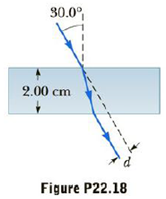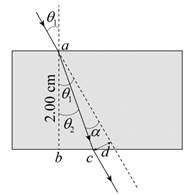
Concept explainers
A ray of light strikes a flat, 2.00-cm-thick block of glass (n = 1.50) at ail angle of 30.0° with respect to the normal (Fig. P22.18). (a) Find the angle of refraction at the lop surface. (b) Find the angle of incidence at the bottom surface and the refracted angle. (c) Find the lateral distance d by which the light beam is shifted. (d) Calculate the

(a)
Answer to Problem 18P
Explanation of Solution
From Snell’s law, at the first surface,
Here,
Substitute
Conclusion:
Thus, the angle of refraction at the top surface is
(b)
Answer to Problem 18P
Explanation of Solution
The upper surface and the lower surface are parallel, the angle of incidence at the lower surface will be
The angle of refraction is,
Substitute
Conclusion:
Thus, the angle of incidence at the bottom surface is
(c)
Answer to Problem 18P
Explanation of Solution
The following diagram shows the sketch of the path of the ray.

From the figure,
Also,
Thus, the lateral distance by which the light beam is shifted is,
Conclusion:
Thus, the lateral distance by which the light beam is shifted is
(d)
Answer to Problem 18P
Explanation of Solution
The equation for the speed of light in glass is,
Substitute
Conclusion:
Thus, the speed of light in the glass is
(e)
Answer to Problem 18P
Explanation of Solution
The equation for time required for the light to travel through the glass is,
Substitute
Conclusion:
Thus, the time required for the light to travel through the glass is
(f)
Answer to Problem 18P
Explanation of Solution
A change in the angle of incidence will cause a change in the angle of refraction. Thus, the distance the distance travelled by the light also changes. So, the travel time will also change.
Conclusion:
Yes, the travel time through the block is affected by the angle of incidence.
Want to see more full solutions like this?
Chapter 22 Solutions
COLLEGE PHYSICS (HIGH SCHOOL EDITION)
- A light ray traveling in air is incident on one face of a rightangleprism with index of refraction n = 1.50, as shown inFigure P22.54, and the ray follows the path shown in the figure.Assuming Θ = 60.0° and the base of the prism is mirrored,determine the angle Φ made by the outgoing ray with the normalto the right face of the prism.arrow_forwardA parallel beam of light enters a glass hemisphere perpendicularto the flat face, as shown in Figure P23.53. The radius ofthe hemisphere is R = 6.00 cm, and the index of refraction isn = 1.56. Determine the point at which the beam is focused.(Assume paraxial rays; i.e., assume all rays are located closeto the principal axis.)arrow_forwardA ray of light strikes a flat,2.00-cm-thick block of glass(n = 1.50) at an angle of 30.0°with respect to the normal (Fig.P22.18). (a) Find the angle ofrefraction at the top surface. (b)Find the angle of incidence at thebottom surface and the refractedangle. (c) Find the lateral distanced by which the light beam isshifted. (d) Calculate the speed oflight in the glass and (e) the time required for the light topass through the glass block. (f) Is the travel time through theblock affected by the angle of incidence? Explain.arrow_forward
- Light travels from air into an optical fiber with an index of refraction of 2.5. (a) In which direction does the light bend? (b) If the angle of incidence on the end of the fiber is 25o, what is the angle of refraction inside the fiber? ( c) Sketch the path of light as it changes media. n1 = 1.00 n2= 2.5arrow_forwardglass of ethanol (n = 1.36) has an ice cube (n = 1.309) floating in it. A light beam in the ethanol goes into the ice cube at an angle of refraction of 85.0 . Find (a) the angle of incidence in the ethanol and (b) the ratio of the wavelength of the light in ice to its wavelength in ethanol.arrow_forwardA block of crown glass is immersed in water as in the figure shown below. A light ray is incident on the top face at an angle of 0₁= = 43.0° with the normal and exits the block at point P. (Assume that x = 3.78 cm.) X P O 102 (a) Find the vertical distance y from the top of the block to P. cm (b) Find the angle of refraction of the light ray leaving the block at P.arrow_forward
- A ray of light traveling through air encounters a 1.2-cm-thick sheet of glass at a 35° angle of incidence. How far does the light ray travel in the glass before emerging on the far side?arrow_forwardA block of crown glass is immersed in water as in the figure below. A light ray is incident on the top face at an angle of 01 = 42° with the normal and exits the block at point P. 3.50 cm 01 02 (a) Find the vertical distance y from the top of the block to P, (b) Find the angle of refraction 62 of the light ray leaving the block at P.arrow_forwardThe critical angle for total internal reflection at a liquid-air interface is 42.5◦.at. If a ray of light traveling in the liquid has an angle of incidence at the interface of 35◦,what angle does the ray refracted in air make with the normal?b. If a ray of light traveling through air has an angle of incidence at the interfaces of 35◦, what angle does the ray refracted in the liquid make with the normal?arrow_forward
- A light ray traveling in air strikes the surface of a slab of glass at an angle of incidence of 50°, Part of the light is reflected and part is refracted.. Find the angle the refracted ray makes with respect to the normal to the airiglass interface. For the toolbar, press ALT+F10 (PC) or ALT+FN+F10 (Mac). B IUS Paragraph Arial 10pt * G自Q x X, ४ ४ + ABC 田 日田田国 Í (1} © © O OWORDS POWERED BY TINY Sve All Answers Speand Submit 7 AM Click Save and Submit to save and submit, Click Save All Answers to save all answers. R. W 田 国arrow_forwardPlz provide the complete situation for advanced physics asap.arrow_forwardA light ray travels from air (n=1.00) into a crown glass (n=1.52) with an angle of incidence of 49 degrees. The light ray continues to travel through the crown glass material into the diamond (n=2.42). At what angle does the light ray make with the normal line as it enters the diamond?arrow_forward
 College PhysicsPhysicsISBN:9781285737027Author:Raymond A. Serway, Chris VuillePublisher:Cengage Learning
College PhysicsPhysicsISBN:9781285737027Author:Raymond A. Serway, Chris VuillePublisher:Cengage Learning College PhysicsPhysicsISBN:9781305952300Author:Raymond A. Serway, Chris VuillePublisher:Cengage Learning
College PhysicsPhysicsISBN:9781305952300Author:Raymond A. Serway, Chris VuillePublisher:Cengage Learning Physics for Scientists and EngineersPhysicsISBN:9781337553278Author:Raymond A. Serway, John W. JewettPublisher:Cengage Learning
Physics for Scientists and EngineersPhysicsISBN:9781337553278Author:Raymond A. Serway, John W. JewettPublisher:Cengage Learning Physics for Scientists and Engineers with Modern ...PhysicsISBN:9781337553292Author:Raymond A. Serway, John W. JewettPublisher:Cengage Learning
Physics for Scientists and Engineers with Modern ...PhysicsISBN:9781337553292Author:Raymond A. Serway, John W. JewettPublisher:Cengage Learning Principles of Physics: A Calculus-Based TextPhysicsISBN:9781133104261Author:Raymond A. Serway, John W. JewettPublisher:Cengage Learning
Principles of Physics: A Calculus-Based TextPhysicsISBN:9781133104261Author:Raymond A. Serway, John W. JewettPublisher:Cengage Learning Physics for Scientists and Engineers: Foundations...PhysicsISBN:9781133939146Author:Katz, Debora M.Publisher:Cengage Learning
Physics for Scientists and Engineers: Foundations...PhysicsISBN:9781133939146Author:Katz, Debora M.Publisher:Cengage Learning





